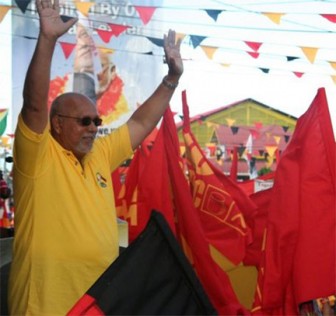President Donald Ramotar is the first Guyanese Head of State ever to have to compete for the presidential candidature. These are different political times. Both the ruling People’s Progressive Party/CIVIC and the People’s National Congress/Reform have been seeking to place a façade of democratic behaviour on their modus operandi. That includes making changes to the processes by which they elect their presidential candidates. The era of the maximum leader is over and Prersident Ramotar and Opposition Leader David Granger are experimental guinea pigs for the selection process for presidential candidates.
Even inside the PPP/C there appeared to be no unanimity on Donald Ramotar’s candidature. While the names of some of the competing candidates appeared suspiciously like red herrings, that could not be said of the name of Ralph Ramkarran, a long-time PPP stalwart, former Speaker of the National Assembly who is widely regarded as a large part of the intellectual engine room of the ruling party. The contest may have come to a shuddering halt once Bharrat Jagdeo threw his weight behind the Ramotar candidature but the response from the Ramkarran supporters left little doubt that there was a fair measure of disgruntlement about the choice of Ramotar.
Donald Ramotar’s reaction to being chosen as the PPP/C’s presidential candidate strongly suggests that he felt he had much to be grateful to Bharrat Jagdeo for. Not only did he shower the then President of the Republic with generous enkomiums, he also allowed himself to become part of an orchestrated “process” towards the presidency designed as much to give his predecessor a rousing sendoff as to welcome him into office.

There was no winding down of the Jagdeo presidency. It ended only when Donald Ramotar was sworn in as President. Before that Mr. Ramotar had to endure the elaborate charade of a ‘third term’ gimmick reportedly orchestrated by enthusiastic Jagdeoites and which Bharrat Jagdeo did less than he could have to kill off before it began to cast a damper on Mr. Ramotar’s campaign. The Ramotar campaign itself was, at times, an enigma, cast in such a manner as if to make it appear that the PPP/C’s presidential candidate’s campaign was being run by the President himself. It did not take long for the whole affair to descend into a charade. The opposition political parties accused President Jagdeo of giving the Ramotar campaign a huge financial ‘leg up’ by financing Ramotar’s campaign appearances. At that point the President promptly appointed Mr. Ramotar a Presidential Adviser, a move that did no more than confirm the initial farce.
The point about all this is that, arguably, President Ramotar could well have done without having his campaign smothered by his predecessor, a circumstance that has taken some of what is supposed to be the ‘glitter’ off of his own inauguration. It will be recalled that just weeks before the November 28 poll President Jagdeo’s supporters organized a massive ‘send-off’ at the National Stadium at Providence. No comparable welcome party has been held for President Ramotar.
It may well be that in the fullness of time President Ramotar will adopt his own presidential style – so to speak and create his own political ‘fan base’ though it has to be said that in more ways than one he is likely to be reminded that he is no Bharrat Jagdeo.
If no one is suggesting that President Ramotar take a rash of decisions that will do no more than get him a measure of public attention, it has to be said that he has not, since his auguration, dropped any really strong hint of a policy direction that differs from anything that the Jagdeo regime has done. Two other points are worthy of mention here. First, by making no more than a handful of minor cabinet changes President Ramotar has failed to place a distinguishing imprimatur on his administration. Secondly, by having to deal with the current logjam of corruption charges all of which are throwbacks to the Jagdeo administration President Ramotar’s administration has been denied the ‘clean slate’ with which, some may argue, it should begin.
If little of substance has occurred in the realm of foreign policy since President Ramotar’s accession to office, his attendance at the recently concluded CARICOM Heads of Government Conference in St. Lucia at least allowed him to make a foreign policy pronouncement of some measure of importance. Here again he was perhaps ‘sold short’ by a section of the media which appeared unable to say a great deal about his presentation apart from the fact that he was advocating that the region hasten the implementation of the Jagdeo Initiative on Agriculture. One has to wonder whether President Ramotar’s maiden speech to a CARICOM summit might not have been an ideal opportunity to have him make a pronouncement that lends a sense of identity to his presidency.
The Linden crisis, unquestionably the biggest political challenge of President Ramotar’s tenure may well have provided him with an opportunity not only to raise his personal profile but also to demonstrate a capacity to act decisively in a difficult situation. It turned out that the President took far too long to personally engage in the Linden crisis, allowing the demonstrations and lockdown that followed the shooting to death by police of three Lindeners and the subsequent call for Home Affairs Minister Clement Rohee’s removal from office to supersede a decisive intervention on his part in an effort to at least directly engage the people of Linden. That, Mr. Ramotar’s critics might say, was perhaps his best opportunity yet to kickstart his own presidency and banish the image of a President who is still languishing in his predecessor’s shadow.





